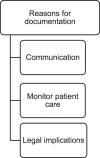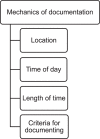Athletic Trainers' Reasons for and Mechanics of Documenting Patient Care: A Report From the Athletic Training Practice-Based Research Network
- PMID: 28574751
- PMCID: PMC5517121
- DOI: 10.4085/1062-6050-52.3.14
Athletic Trainers' Reasons for and Mechanics of Documenting Patient Care: A Report From the Athletic Training Practice-Based Research Network
Abstract
Context: Documenting patient care is an important responsibility of athletic trainers (ATs). However, little is known about ATs' reasons for documenting patient care and the mechanics of completing documentation tasks.
Objective: To understand ATs' perceptions about reasons for and the mechanics of patient care documentation.
Design: Qualitative study.
Setting: Individual telephone interviews with Athletic Training Practice-Based Research Network members.
Patients or other participants: Ten ATs employed in the secondary school setting (age = 32.6 ± 11.4 years, athletic training experience = 7.1 ± 7.8 years) were recruited using a criterion-based sampling technique. Participants were Athletic Training Practice-Based Research Network members who used the Clinical Outcomes Research Education for Athletic Trainers electronic medical record system and practiced in 6 states.
Data collection and analysis: We used the consensual qualitative research tradition. One investigator conducted individual telephone interviews with each participant. Data collection was considered complete after the research team determined that data saturation was reached. Interviews were transcribed verbatim and independently analyzed by 4 research team members following the process of open, axial, and selective coding. After independently categorizing interview responses into categories and themes, the members of the research team developed a consensus codebook, reanalyzed all interviews, and came to a final agreement on the findings. Trustworthiness was established through multiple-analyst triangulation and member checking.
Results: Participants identified 3 reasons for documenting patient care: communication, monitoring patient care, and legal implications. Four subcategories emerged from the mechanics-of-documentation theme: location, time of day, length of time, and criteria for documenting. The ATs described different criteria for documenting patient care, ranging from documenting every injury in the same manner to documenting time-loss and follow-up injuries differently.
Conclusions: Whereas ATs recognized individual mechanisms that enabled them to document patient care, they may need more guidance on the appropriate criteria for documenting various patient care encounters and strategies to help them document more effectively.
Keywords: CORE-AT EMR; electronic medical record; health care administration; secondary school setting.
Figures
Similar articles
-
Athletic Trainers' Perceptions of and Barriers to Patient Care Documentation: A Report From the Athletic Training Practice-Based Research Network.J Athl Train. 2017 Jul;52(7):667-675. doi: 10.4085/1062-6050-52.3.15. Epub 2017 Jun 2. J Athl Train. 2017. PMID: 28574752 Free PMC article.
-
Patient Care Documentation in the Secondary School Setting: Unique Challenges and Needs.J Athl Train. 2020 Oct 1;55(10):1089-1097. doi: 10.4085/1062-6050-0406.19. J Athl Train. 2020. PMID: 32966580 Free PMC article.
-
Future Strategies to Enhance Patient Care Documentation Among Athletic Trainers: A Report From the Athletic Training Practice-Based Research Network.J Athl Train. 2018 Jun;53(6):619-626. doi: 10.4085/1062-6050-298-17. Epub 2018 Jun 12. J Athl Train. 2018. PMID: 29893602 Free PMC article.
-
Evidence-Based Considerations and Recommendations for Athletic Trainers Caring for Patients With Attention-Deficit/Hyperactivity Disorder.J Athl Train. 2016 Oct;51(10):813-820. doi: 10.4085/1062-6050-51.12.11. Epub 2016 Nov 11. J Athl Train. 2016. PMID: 27834506 Free PMC article. Review.
-
Athletic Trainer Accessibility in U.S. High Schools: A Systematic Review and Meta-Analysis.Curr Sports Med Rep. 2025 May 1;24(5):106-115. doi: 10.1249/JSR.0000000000001248. Curr Sports Med Rep. 2025. PMID: 40323055
Cited by
-
Athletic Training Services During Daily Patient Encounters: A Report From the Athletic Training Practice-Based Research Network.J Athl Train. 2016 Jun 2;51(6):435-41. doi: 10.4085/1062-6050-51.8.03. Epub 2016 Jun 17. J Athl Train. 2016. PMID: 27315222 Free PMC article.
-
Organizational Expectations Regarding Documentation Practices in Athletic Training.J Athl Train. 2024 Feb 1;59(2):212-222. doi: 10.4085/1062-6050-0062.23. J Athl Train. 2024. PMID: 37459373 Free PMC article.
-
National Athletic Trainers' Association Position Statement: Emergency Action Plan Development and Implementation in Sport.J Athl Train. 2024 Jun 1;59(6):570-583. doi: 10.4085/1062-6050-0521.23. J Athl Train. 2024. PMID: 38918009 Free PMC article.
-
Athletic Trainers' Practice Patterns Regarding Medical Documentation.J Athl Train. 2019 Jul;54(7):822-830. doi: 10.4085/1062-6050-230-18. Epub 2019 Aug 6. J Athl Train. 2019. PMID: 31386576 Free PMC article.
-
Cost and Treatment Characteristics of Sport-Related Knee Injuries Managed by Athletic Trainers: A Report From the Athletic Training Practice-Based Research Network.J Athl Train. 2021 Aug 1;56(8):922-929. doi: 10.4085/1062-6050-0061.20. J Athl Train. 2021. PMID: 33237998 Free PMC article.
References
-
- Johnson SB. . The 2009 Athletic Trainer Role Delineation Study. 6th ed. Omaha, NE: Board of Certification, Inc; 2010.
-
- BOC standards of professional practice. Board of Certification Web site. http://www.bocatc.org/images/stories/multiple_references/standardsprofes.... Published January 2006. Accessed December 19, 2016.
-
- Athletic training education competencies. 5th ed. National Athletic Trainers' Association Web site. https://www.nata.org/sites/default/files/competencies_5th_edition.pdf. Published 2011. Accessed December 19, 2016.
-
- Documentation and coding guidelines for athletic trainers. National Athletic Trainers' Association Web site. https://www.nata.org/sites/default/files/Documentation-and-Coding-Guidel.... Accessed December 19, 2016.
-
- Penoyer DA, Cortelyou-Ward KH, Noblin AM, et al. . Use of electronic health record documentation by healthcare workers in an acute care hospital system. J Healthc Manag. 2014; 59 2: 130– 144. - PubMed
MeSH terms
LinkOut - more resources
Full Text Sources
Other Literature Sources



